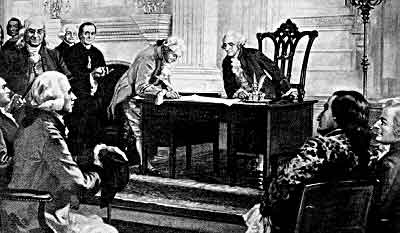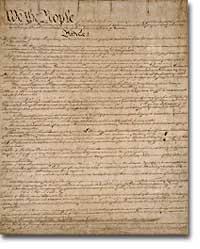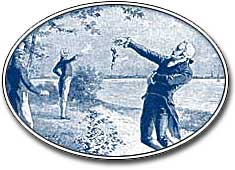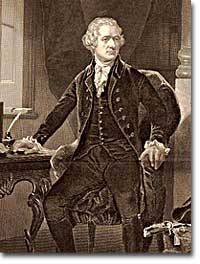2c. Creating the Constitution
"Nothing spoken or written can be revealed to anyone — not even your family — until we have adjourned permanently. Gossip or misunderstanding can easily ruin all the hard work we shall have to do this summer." -George Washington, presiding officer

The Constitution was written in secrecy over a summer in Philadelphia. Twelve of the thirteen states were represented. Once the drafters signed the Constitution, as seen here, it began to make a slow path around the states in search of ratification.
Constitutional Convention
Most of the delegates at the Constitutional Convention had already risked being hanged as traitors by the British. No wonder that they worried about their states' reactions to their decision to abandon the Articles of Confederation and create a whole new document.
Persuading the states to accept the Constitution was every bit as difficult as they predicted. It took two years for all thirteen states to ratify it. But their product was a blueprint for a new kind of government based on the principles of separation of powers, checks and balances, and federalism.
Separation of Powers

The Constitution is the basis of the United States government. All debates over laws have the few pages of the Constitution as their basis, and much political conflict has arisen due to different traditions of interpreting its clauses.
The Constitution provided for the structure and powers of Congress in Article I. It created a bicameral legislature, set qualifications for holding office in each house, and provided for methods of selecting representatives and senators. It carefully enumerated powers, such as regulating interstate commerce and declaring wars. Article II vested the power to execute laws in a president of the United States. It set the president's term at four years, stated qualifications for office, and provided a mechanism to remove him from office.
The president's constitutional powers are very modest, but they include commander-in-chief of the armed forces, negotiator of foreign treaties, and appointer of ambassadors, judges, and other "officers of the United States." Article III established a Supreme Court and defines its jurisdiction. The Founders disagreed on how much power to give the judges, but they ultimately gave judges appointments for life and forbid Congress to lower their salaries while they hold office.
Checks and Balances
The Founders were ever mindful of the dangers of tyrannical government. So they built a system in which the powers of each branch would be used to check the powers of the other two branches. Additionally, each house of the legislature could check one another. For example, both houses of Congress must vote to enact laws, the president can veto legislation, and the Supreme Court can rule laws unconstitutional. Congress can override presidential vetoes. The president nominates Supreme Court justices, but the Senate can refuse to confirm the nominees. The Congress can impeach and remove the president or a member of the Supreme Court. As a result, a "balance" was created among the three branches.

He may have been an elegant and refined statesman, but Alexander Hamilton's temper got him involved in a duel with Aaron Burr that resulted in death.
Wide differences of opinion existed even among the 55 delegates concerning the proper balance between liberty and order. Alexander Hamilton, for example, valued order more than liberty and supported the creation of a very strong executive. James Madison, influenced by his mentor Thomas Jefferson, conceded that an executive was necessary, but he saw the legislature as the preserver of liberty and an important check on the power of the executive. George Washington's experience as the head of the Continental Army during the revolution convinced him that the chaotic government needed more structure. Thomas Jefferson did not attend the convention because he was serving as ambassador to France, but his belief that "a little rebellion now and then" was a good thing tilted his balance more toward liberty.
Federalism
Article IV defined the relationship between the federal government and the states in a system of federalism, which divides the power of government between national and state governments. This federal system was meant to correct the chaos of the country during the Articles of Confederation. However, it was still mindful of the threat of a tyrannical central government. This article included mechanisms for admitting new states to the Union.

Alexander Hamilton was one of the most important proponents of federalism at the Constitutional Convention. He presented a plan to create a strong executive branch, out of a belief that order is more important than liberty.
The relationship between national and state governments was defined in many other parts of the Constitution. For example, Article 1, Section 10 forbids the states to form alliances or enter with foreign countries or to coin their own money. Federalism was further defined in Article VI in which the constitution was declared "the Supreme Law of the Land." This supremacy clause, as well as the "elastic" clause (Article I, Section 8) tilts the federalist balance toward national law.
Article V provides methods of amending the Constitution. Only 27 amendments have been added to the constitution since the ratification in 1789.
The Founders acted boldly in 1787 when they threw out the Articles of Confederation and created the Constitution. The document they created has survived for more than 200 years. The risks that they took resulted in the longest lasting written constitution in world history.








